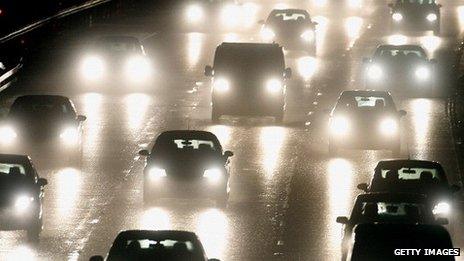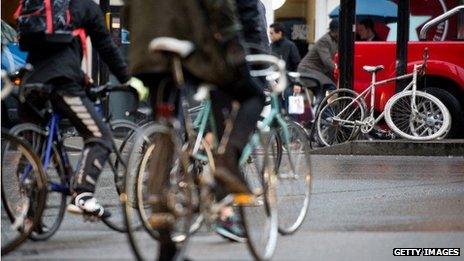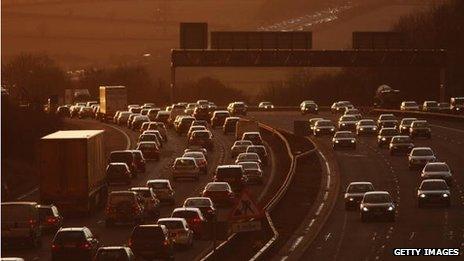Cars 'still dominate commute to work'
- Published
- comments

Seven out of 10 people in rural areas get to work by car rather than the train or bus, the RAC claimed
The vast majority of people in England and Wales still commute to work by car, according to a new report.
The RAC Foundation report crunched the numbers from the last census in 2011 and the National Travel Survey.
It said six in 10 commuters either drive or grab a lift in a car or a van - 16.7 million people - which rises to more than seven in 10 when you single out rural areas.
The second most popular journey is by foot, with almost 2.9 million walking.
Catching the bus or coach is third, followed by the train, and then the underground, tram, or metro. Cycling sits below that, with 762,334 people biking to the office.
"The astonishing thing is the level of car reliance amongst urban workers, not just those who live in rural areas," said Stephen Glaister, director of the RAC Foundation.
There are a few little shocks buried inside this report though, which make for fascinating reading.

Only about 4% of people use bikes to get to work
London, for example, has a congestion charge, terrible parking and pretty good public transport, but the car remains the most popular way to commute.
Nearly a third of workers rely on a car or van to get in. The tube does come in a close second, with more than fifth of workers using the underground. Then comes the bus and the train, followed by walking, and cycling (around 4% get on their bike).
More than twice as many people walk than cycle.
There's a nice breakdown of the local authority areas where most people drive to work too. And a word of advice: if you sell cars for a living, open a showroom in Wales, where nearly three-quarters of workers use a car or van to commute. Blaenau Gwent tops the charts, with more than eight in every 10 workers in the area driving in.
The areas with the fewest number of people driving to the office are all in London - the boroughs of City of London, Islington, Westminster and Camden.

The cost of motoring is still on the up, says the RAC Foundation
Being the RAC Foundation, there is a heavy emphasis on the cost of motoring.
It highlights just how expensive driving has become, with the price of fuel and oil going up twice as fast as the cost of living over the past decade. It says that 800,000 of the poorest car-owning households spend more than a quarter of their disposable income on buying and running a car.
"The coalition government has rightly prioritised efforts to get the nation working, but it has to remember how the nation actually travels to work," Mr Glaister said.
"People are still driving despite a decade in which the cost of running a car has outstripped wage inflation. Transport poverty is a real threat to the economy. There would be uproar if domestic heating was taxed at 60%, so why is it acceptable for road fuel to attract such high taxation?"
So the message from all this then?
Despite all the talk of HS2 high-speed trains and bikes and working from home, most people drive to work. And that's not going to change any time soon.
- Published2 December 2013
- Published5 June 2013
- Published5 June 2013